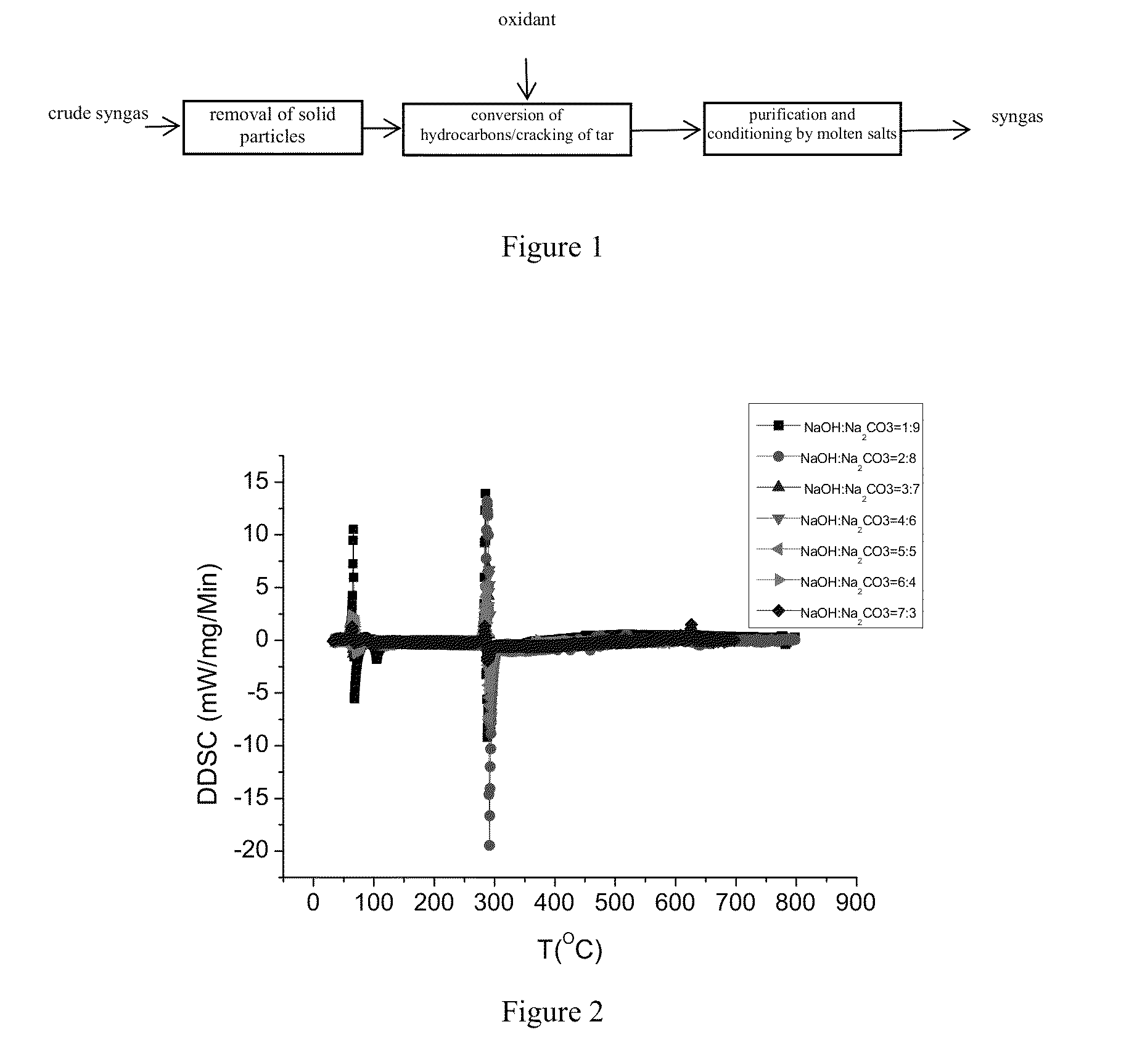Method for purification and conditioning of crude syngas based on properties of molten salts
a technology of crude syngas and properties, applied in the field of new purification and conditioning methods of crude syngas, to achieve the effects of long process flow, large difficulty in operation and design, and high investment cos
- Summary
- Abstract
- Description
- Claims
- Application Information
AI Technical Summary
Benefits of technology
Problems solved by technology
Method used
Image
Examples
embodiment 1
[0027]As shown in FIG. 1, the embodiment comprises the following steps:[0028](1) Particles removed at high-temperature: enabling the high-temperature crude syngas produced by a gasification device to firstly pass through a high-temperature particle removal device to remove solid particles in the gas;[0029](2) Removal of hydrocarbons in the presence of oxygen: introducing an oxidant into the crude syngas after treatment in step (1), selectively removing the hydrocarbons in the crude syngas and simultaneously utilizing high temperature produced by oxidation of the hydrocarbons to crack tar, wherein the heat produced in the process can also be used for adjusting the temperature of the crude syngas and thus controlling the reaction temperature in step (3); and[0030](3) Removal of gas pollutants and conditioning: introducing the crude syngas obtained in step (2) into molten salts medium, removing pollutants containing sulfur and chlorine in the crude syngas, and simultaneously adjusting ...
embodiment 2
[0038]The oxidant in step (2) can be NiO. The stoichiometric ratio of the amount of the oxidant introduced into the crude syngas to the hydrocarbons in the crude syngas is about 0.35.
[0039]In the embodiment, the molten salts adopts NaOH+KOH, the mass ratio is that mNaOH:mKOH=50:50, and the melting point of the molten salts is 170° C.;
[0040]The operating temperature of the molten salts medium is within 500° C.; and the molten state of the molten salts can be kept within the temperature range.
[0041]In addition to the above conditions, other working conditions are the same with the embodiment 1. The prepared syngas is as shown in Table 3.
[0042]
TABLE 3Syngas Prepared After Treatment by Process of the InventionH2CH4COCO2C2HmTarSClNo.(Vol %)(Vol %)(Vol %)(Vol %)(Vol %)H2 / CO(g / m3)(mg / m3)(mg / m3)178.7020.90.403.9ND0.068ND280.0020.0004.10.010.045ND379.1020.9003.7ND0.511.1
embodiment 3
[0043]The oxidant in step (2) can be Fe2O3 and 50% oxygen-rich air. The stoichiometric ratio of the amount of the oxidant introduced into the crude syngas to the hydrocarbons in the crude syngas is about 0.25.
[0044]In the embodiment, the molten salts adopts NaOH+LiOH, the mass ratio is that mNaOH:mLiOH=75:25, and the melting point of the molten salts is 215° C.;
[0045]The operating temperature of the molten salts medium is within 600° C.; and the molten state of the molten salts can be kept within the temperature range.
[0046]In addition to the above conditions, other working conditions are the same with embodiment 1. The prepared syngas is as shown in Table 4.
[0047]
TABLE 4Syngas Prepared After Treatment by Process of the InventionH2CH4COCO2C2HmTarSClNo.(Vol %)(Vol %)(Vol %)(Vol %)(Vol %)H2 / CO(g / m3)(mg / m3)(mg / m3)190.50.88.50.2010.6ND0.08ND* Component after removal of N2
PUM
| Property | Measurement | Unit |
|---|---|---|
| operating temperature | aaaaa | aaaaa |
| melting point | aaaaa | aaaaa |
| temperature | aaaaa | aaaaa |
Abstract
Description
Claims
Application Information
 Login to View More
Login to View More - R&D
- Intellectual Property
- Life Sciences
- Materials
- Tech Scout
- Unparalleled Data Quality
- Higher Quality Content
- 60% Fewer Hallucinations
Browse by: Latest US Patents, China's latest patents, Technical Efficacy Thesaurus, Application Domain, Technology Topic, Popular Technical Reports.
© 2025 PatSnap. All rights reserved.Legal|Privacy policy|Modern Slavery Act Transparency Statement|Sitemap|About US| Contact US: help@patsnap.com


